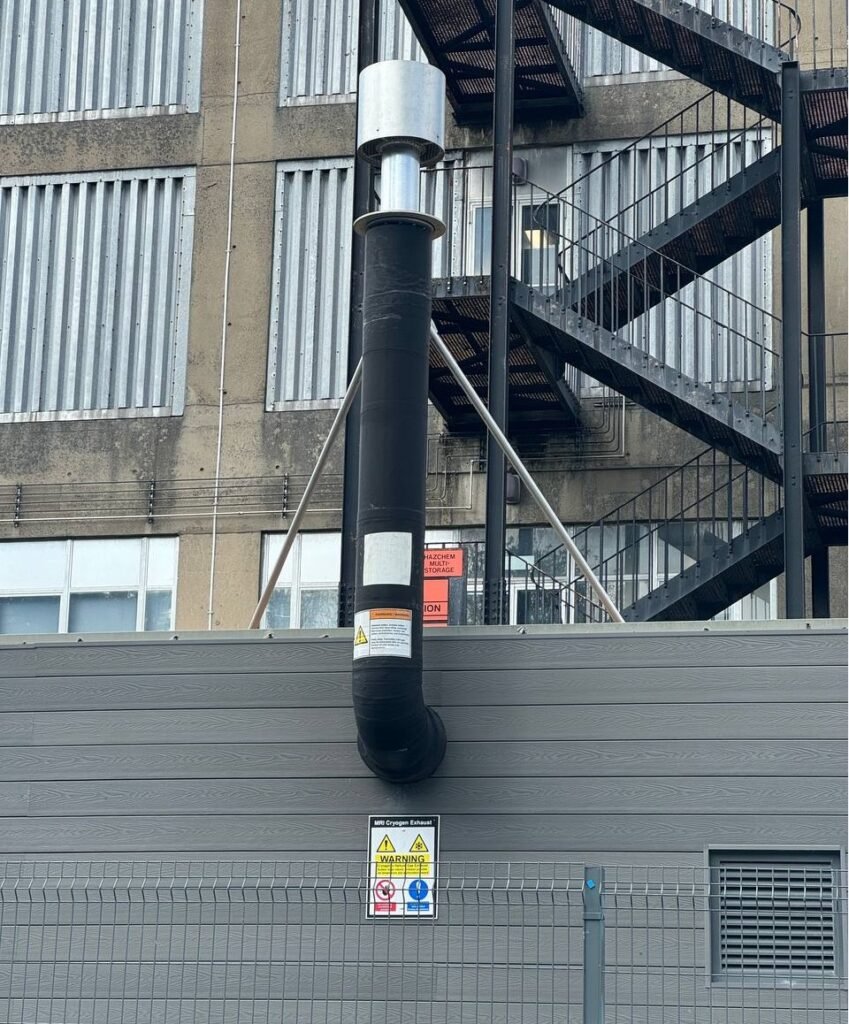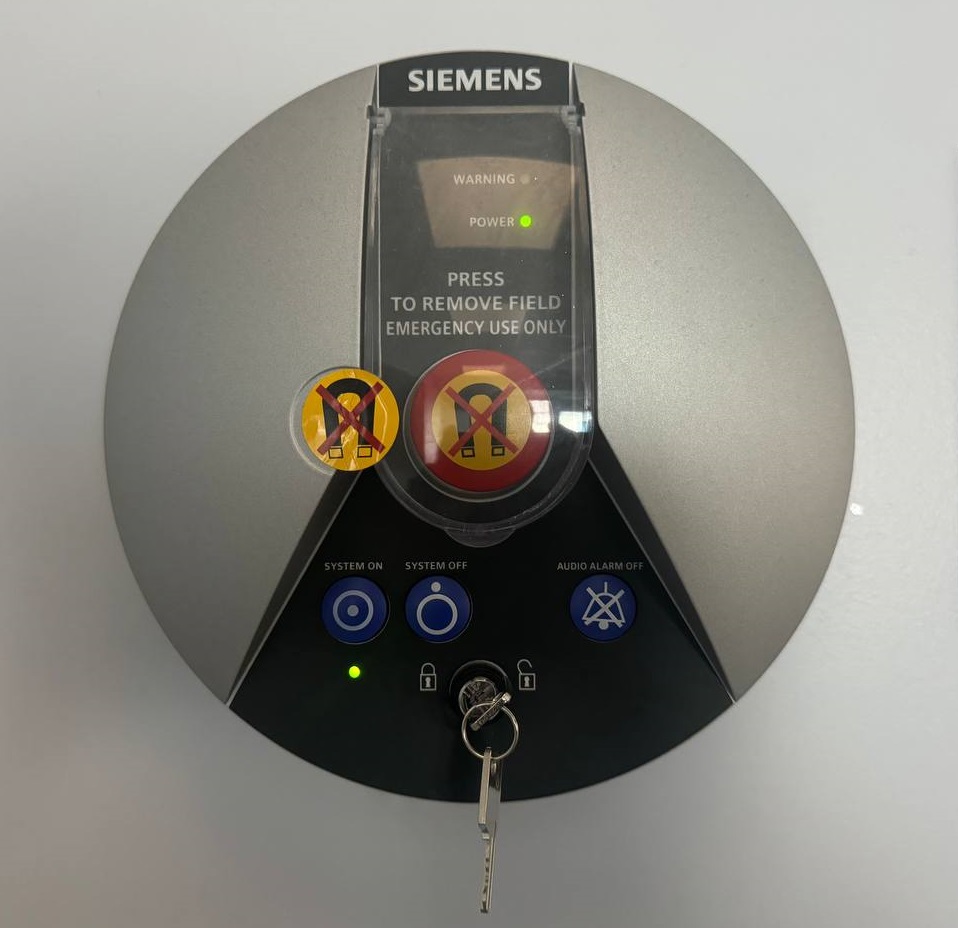MRI Magnet Quench (Quench protocol)
In the context of MRI , a “quench” refers to the sudden loss of superconductivity in the MRI’s magnet, resulting in the rapid boiling off of the liquid helium coolant. This process causes the magnetic field to drop to zero in a very short period. A quench is generally considered a safety mechanism or an emergency procedure when it becomes necessary to shut down the magnetic field quickly.
What Happens During a Quench
Superconducting magnets are essential in MRI machines because they can produce a strong and stable magnetic field, vital for effective imaging. These magnets are cooled to extremely low temperatures with liquid helium to maintain superconductivity. A quench occurs when something disrupts the superconducting state, resulting in a loss of superconductivity. This change forces the magnet into a normal resistive state, leading to rapid heating and a quick evaporation of the liquid helium. The rapidly expanding helium gas is then safely vented from the building via a quench pipe to prevent any pressure build-up and potential risks or damage in the scanner room.
MRI quench pipe


Where is the Quench Button Located?
The quench button in an MRI system is typically located in the magnet room itself or on the MRI console, within easy reach of the operator. This button is usually covered and marked distinctly as “QUENCH” to prevent accidental activation. It’s designed to be accessible so that it can be quickly pressed in an emergency. The button is directly wired to the magnet and, when pressed, triggers the release of the helium, thus beginning the quench process.
MRI Quench Button


Scenarios for Initiating a Quench
Quenching is generally considered a last-resort measure because of the costs and operational downtime associated with it. Here are some scenarios where a quench might be initiated:
- Medical Emergency: In cases where a patient or staff member is critically injured or trapped in the MRI suite and rapid removal from the magnetic field is required.
- Fire: If a fire occurs in the MRI room, quenching may rarely be necessary to ensure safety and facilitate firefighting efforts.
- Planned Maintenance (initiated solely by a trained engineer): Occasionally, a quench might be planned for servicing or upgrading parts of the magnet system that are inaccessible during normal operation.
- Technical Failure (initiated solely by a trained engineer): In the event of a failure in the cooling system or another critical component malfunction affecting the stability of the magnetic field, a quench may be initiated solely by a trained engineer specializing in magnets.
Automatic Quench
Some conditions, such as excessive pressure build-up in the cooling system or electrical faults, may trigger an automatic quench as a protective measure to prevent damage to the magnet and ensure safety.
Photograph of an MRI quench

Situations Where Quench Should Be Avoided
- Ferromagnetic objects stuck to the magnet: If a ferromagnetic object becomes stuck to the magnet, do not initiate a quench. Quenching will not necessarily release the object and can be extremely costly due to helium loss and potential system damage. Instead, contact the manufacturer or a trained professional to safely ramp down the magnet, gradually decreasing the magnetic field, allowing for the removal of the object in a controlled manner. This is often a cheaper and safer alternative to quenching.
- Blocked or disconnected quench tube: If the tube that safely vents helium becomes blocked or disconnected, quenching could lead to dangerous accumulations of helium in the room, potentially displacing oxygen and posing a life-threatening risk. This situation requires immediate intervention by trained personnel to secure the venting system before any further actions.
Ramp down: Ramp down refers to the controlled process of decreasing the current in the superconducting magnet to gradually bring it from the superconducting state back to its non-superconducting state, without inducing a quench. This is a slower, more controlled process compared to quenching and is used particularly when ferromagnetic objects need to be safely removed from the magnet.
MRI Quench Protocol
The quench protocol in an MRI department is a critical safety procedure designed to handle the rare event of an MRI magnet quench, ensuring the safety of patients, staff, and any bystanders. Here is a detailed protocol that might be followed in such an event:
- Immediate Patient Safety: Remove the patient immediately from the MRI room to prevent any risk of injury from the magnetic field collapse or exposure to escaping gases.
- Evacuation of Personnel: Evacuate all personnel from the MRI room and surrounding areas as quickly as possible. The rapid expansion of helium gas can displace oxygen, creating a risk of asphyxiation.
- Ventilation of the Room: Most MRI rooms are equipped with emergency ventilation systems designed to extract helium gas from the room during a quench. Ensure these systems are activated immediately.
- Prop open the door to the magnet room to aid in ventilation and prevent the buildup of helium gas.
- Handling Helium Gas Escape: If the room is filled with gas and escape through the door is not possible, emergency procedures may include breaking the window glass
- Safety Around Quench Pipe Exit: Check that no one is working or present around the quench pipe exit outside the building. The exit of the helium gas can be lethal if directly encountered due to the force and cold of the escaping gas.
- Monitoring the Environment: Keep all personnel out of the affected area until the air quality has been confirmed to be restored to normal levels. This might involve checking oxygen levels and ensuring that helium has been adequately vented.
- Post-Quench Assessment and Reporting: After a quench, conduct a thorough assessment of the MRI system and the facility. Report the incident to the appropriate health and safety authorities and to the MRI manufacturer for further guidance and to discuss re-ramping the magnet.
- Mobile MRI Scanners: If the MRI is a mobile unit, ensure it is not positioned near paths where high vehicles, such as double-decker buses, pass by. The helium gas should be vented in a location that does not pose a hazard to vehicles or pedestrians.
- Training and Drills: Regular training and emergency drills should be conducted to ensure all staff are familiar with quench procedures and can respond effectively in an emergency.
MRI emergency extraction switch


Re-ramping the Magnet After a Quench
- Inspection and Repairs: Before re-ramping the magnet, it’s crucial to conduct a thorough inspection to determine the cause of the quench and to repair any damage. This might involve replacing parts of the cooling system or the magnet itself.
- Refilling Helium: Refill the magnet with liquid helium to restore the necessary cooling environment for superconductivity.
- Gradual Power Ramp-up: Slowly ramp up the power to the magnet coils. This must be done gradually to ensure the magnet coils return to their superconductive state without incident.
- System Checks: Perform full system diagnostics to ensure all components are functioning correctly and safely.
- Return to Operation: Once all safety checks are confirmed, the MRI can return to normal operational status.


